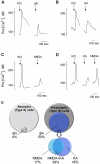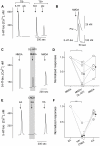Glutamate may be an efferent transmitter that elicits inhibition in mouse taste buds
- PMID: 22292013
- PMCID: PMC3266908
- DOI: 10.1371/journal.pone.0030662
Glutamate may be an efferent transmitter that elicits inhibition in mouse taste buds
Abstract
Recent studies suggest that l-glutamate may be an efferent transmitter released from axons innervating taste buds. In this report, we determined the types of ionotropic synaptic glutamate receptors present on taste cells and that underlie this postulated efferent transmission. We also studied what effect glutamate exerts on taste bud function. We isolated mouse taste buds and taste cells, conducted functional imaging using Fura 2, and used cellular biosensors to monitor taste-evoked transmitter release. The findings show that a large fraction of Presynaptic (Type III) taste bud cells (∼50%) respond to 100 µM glutamate, NMDA, or kainic acid (KA) with an increase in intracellular Ca(2+). In contrast, Receptor (Type II) taste cells rarely (4%) responded to 100 µM glutamate. At this concentration and with these compounds, these agonists activate glutamatergic synaptic receptors, not glutamate taste (umami) receptors. Moreover, applying glutamate, NMDA, or KA caused taste buds to secrete 5-HT, a Presynaptic taste cell transmitter, but not ATP, a Receptor cell transmitter. Indeed, glutamate-evoked 5-HT release inhibited taste-evoked ATP secretion. The findings are consistent with a role for glutamate in taste buds as an inhibitory efferent transmitter that acts via ionotropic synaptic glutamate receptors.
Conflict of interest statement
Figures




Similar articles
-
Glutamate: Tastant and Neuromodulator in Taste Buds.Adv Nutr. 2016 Jul 15;7(4):823S-7S. doi: 10.3945/an.115.011304. Print 2016 Jul. Adv Nutr. 2016. PMID: 27422519 Free PMC article. Review.
-
Calcitonin Gene-Related Peptide Reduces Taste-Evoked ATP Secretion from Mouse Taste Buds.J Neurosci. 2015 Sep 16;35(37):12714-24. doi: 10.1523/JNEUROSCI.0100-15.2015. J Neurosci. 2015. PMID: 26377461 Free PMC article.
-
Evidence for a role of glutamate as an efferent transmitter in taste buds.BMC Neurosci. 2010 Jun 21;11:77. doi: 10.1186/1471-2202-11-77. BMC Neurosci. 2010. PMID: 20565975 Free PMC article.
-
Norepinephrine is coreleased with serotonin in mouse taste buds.J Neurosci. 2008 Dec 3;28(49):13088-93. doi: 10.1523/JNEUROSCI.4187-08.2008. J Neurosci. 2008. PMID: 19052199 Free PMC article.
-
Taste buds as peripheral chemosensory processors.Semin Cell Dev Biol. 2013 Jan;24(1):71-9. doi: 10.1016/j.semcdb.2012.12.002. Epub 2012 Dec 20. Semin Cell Dev Biol. 2013. PMID: 23261954 Free PMC article. Review.
Cited by
-
Glutamate: Tastant and Neuromodulator in Taste Buds.Adv Nutr. 2016 Jul 15;7(4):823S-7S. doi: 10.3945/an.115.011304. Print 2016 Jul. Adv Nutr. 2016. PMID: 27422519 Free PMC article. Review.
-
Calcitonin Gene-Related Peptide Reduces Taste-Evoked ATP Secretion from Mouse Taste Buds.J Neurosci. 2015 Sep 16;35(37):12714-24. doi: 10.1523/JNEUROSCI.0100-15.2015. J Neurosci. 2015. PMID: 26377461 Free PMC article.
-
The effect of imiquimod on taste bud calcium transients and transmitter secretion.Br J Pharmacol. 2016 Nov;173(21):3121-3133. doi: 10.1111/bph.13567. Epub 2016 Sep 6. Br J Pharmacol. 2016. PMID: 27464850 Free PMC article.
-
Taste buds: cells, signals and synapses.Nat Rev Neurosci. 2017 Aug;18(8):485-497. doi: 10.1038/nrn.2017.68. Epub 2017 Jun 29. Nat Rev Neurosci. 2017. PMID: 28655883 Free PMC article. Review.
-
Chemical and electrical synaptic interactions among taste bud cells.Curr Opin Physiol. 2021 Apr;20:118-125. doi: 10.1016/j.cophys.2020.12.004. Epub 2021 Jan 11. Curr Opin Physiol. 2021. PMID: 33521414 Free PMC article.
References
-
- Ogura T. Acetylcholine increases intracellular Ca2+ in taste cells via activation of muscarinic receptors. J Neurophysiol. 2002;87:2643–2649. - PubMed
-
- Lu SG, Zhao FL, Herness S. Physiological phenotyping of cholecystokinin-responsive rat taste receptor cells. Neurosci Lett. 2003;351:157–160. - PubMed
-
- Kaya N, Shen T, Lu SG, Zhao FL, Herness S. A paracrine signaling role for serotonin in rat taste buds: expression and localization of serotonin receptor subtypes. Am J Physiol Regul Integr Comp Physiol. 2004;286:R649–658. - PubMed
-
- Finger TE, Danilova V, Barrows J, Bartel DL, Vigers AJ, et al. ATP signaling is crucial for communication from taste buds to gustatory nerves. Science. 2005;310:1495–1499. - PubMed
Publication types
MeSH terms
Substances
Grants and funding
LinkOut - more resources
Full Text Sources
Miscellaneous

